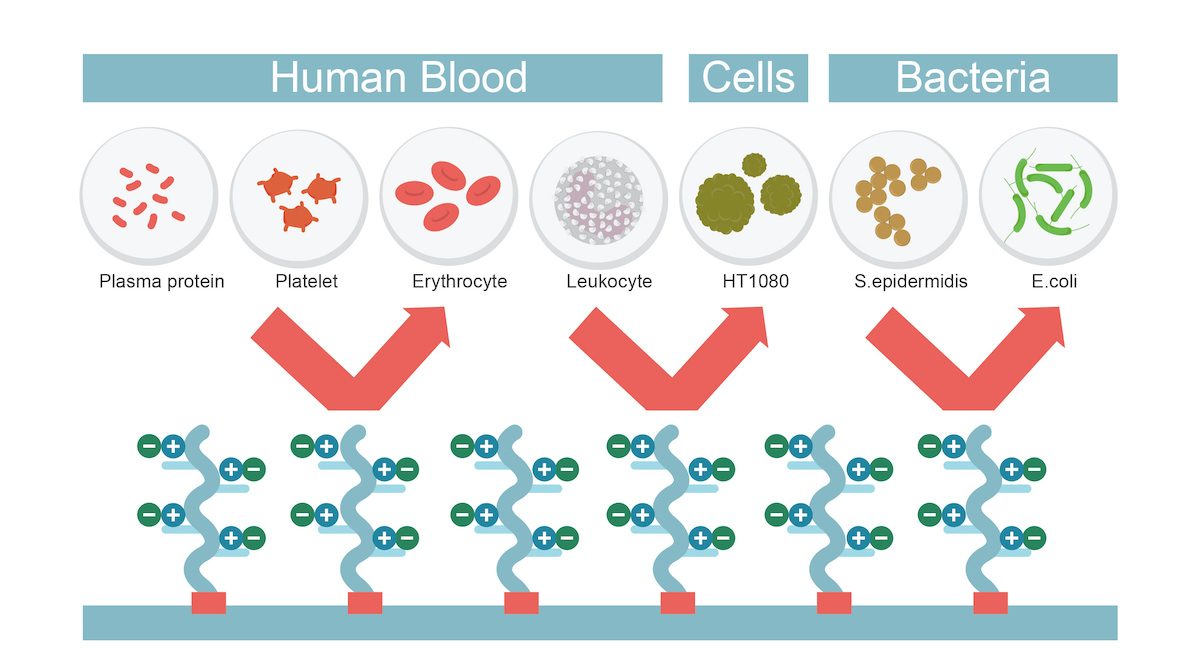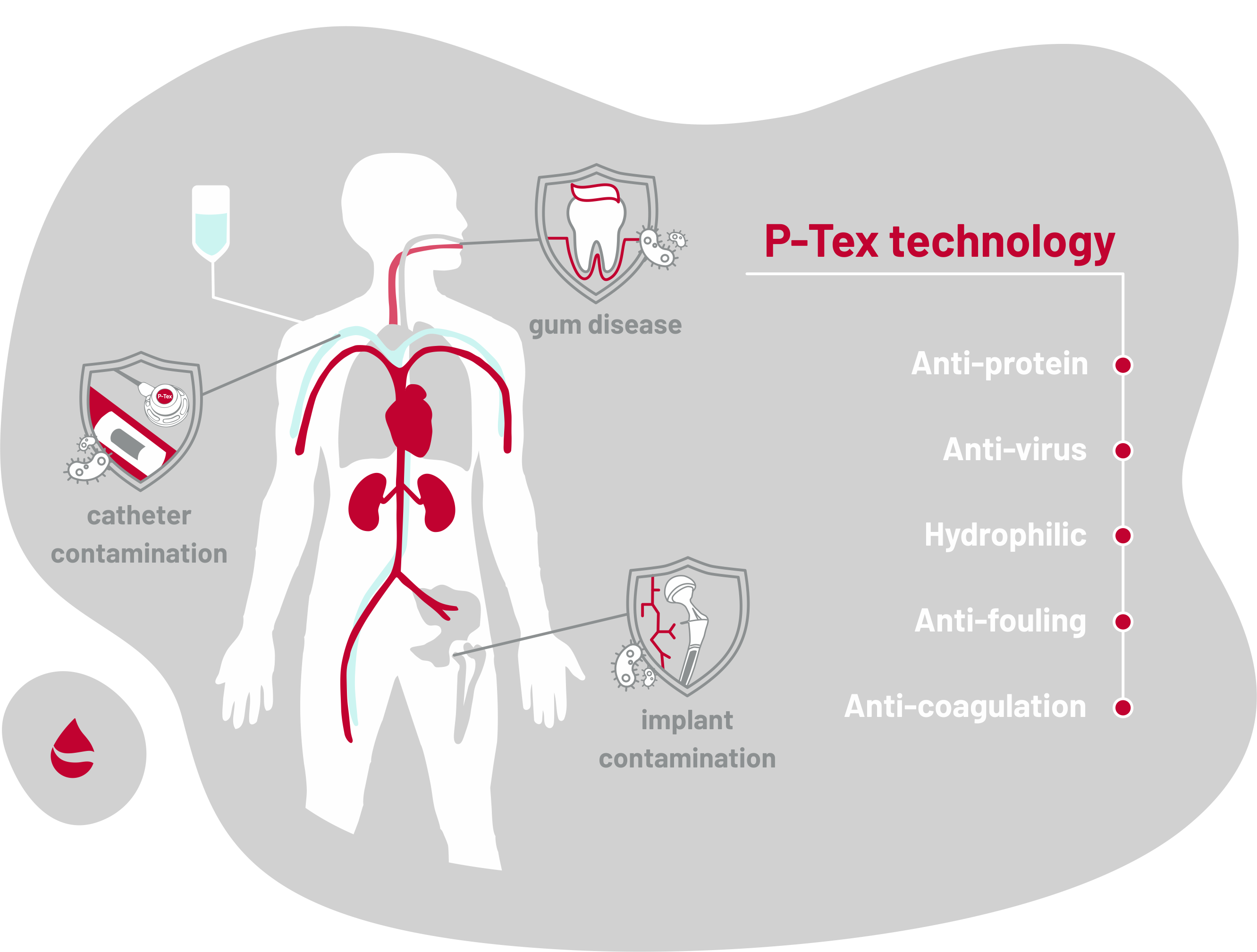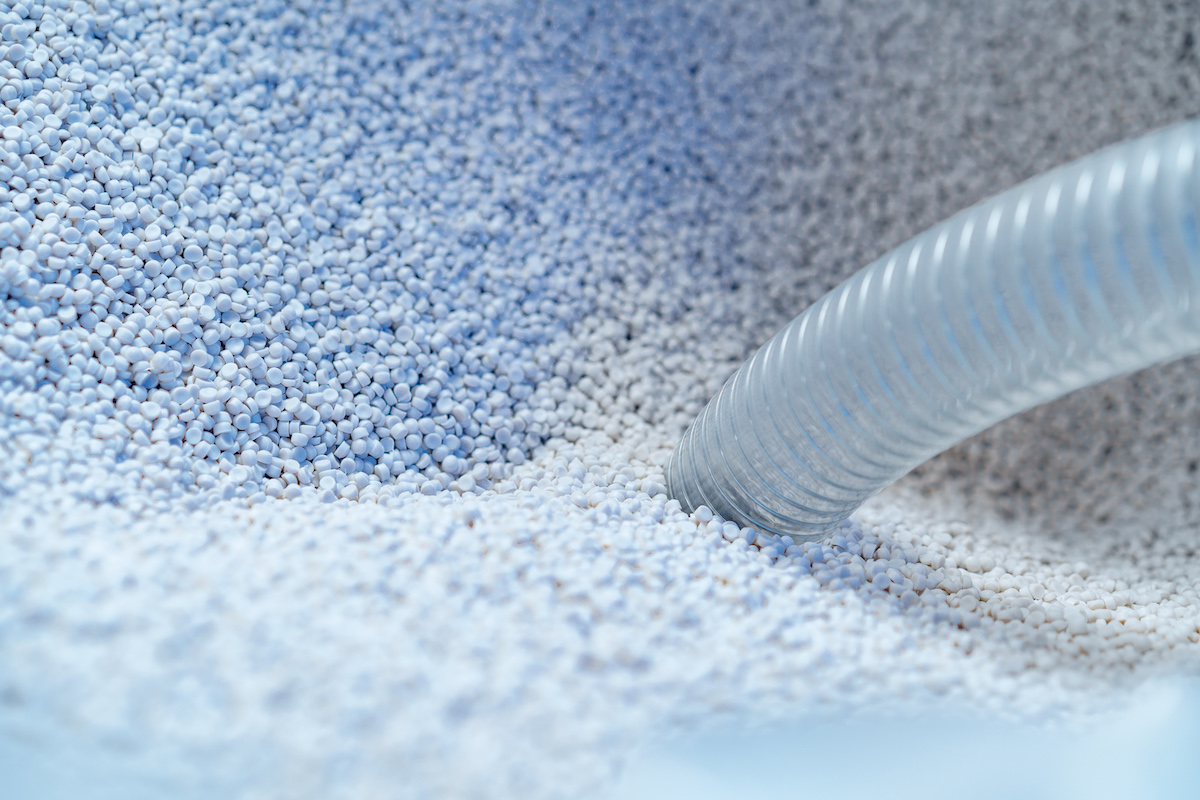The P-Tex could be steadily coated or embedded on the surface or interior of the desired material. It provides the target surface the anti-biofouling property with the feature of highly biocompatibility. With P-Tex processing, the processed material can resist any living creature from attachment while retaining co-existing in the same environment. Now we have discovered features including anti-protein/anti-virus / anticoagulation / anti-tissue adhesion / anti-bacterial / anti-biofouling.
P-Tex is an advanced anti-fouling technology, which is composed by bio-inspired molecular formula – “zwitterionic copolymer structure ” with amphiphilic segments. With aforementioned features, it is an ideal material to apply especially in medical devices reducing the risk of contamination or infection while remaining excellent biocompatibility. The P-Tex coating can be added into any desired material by soaked with a period of time. On the surface of the target material will compose a self-assembled zwitterionic chemical structure, endowing the material with aforementioned features. Through adding the P-Tex into the raw material endowing the material itself with the above-mentioned functions without additional surface coating process. Our current development includes: Industrial plastic additives and medical plastic additives. Endowing the desired material with the following function Leukoreduction filtration system / Dental implant Syringe filter for lab use Wound dressing Medical consumptions (tubing/ cell cultivation bag) Anti-fouling paint on ship or boat Current stage Pending Pending Pending Mei-Chan Sin, Sheng-Han Chen & Yung Chang Fundamental development of nonfouling zwitterionic poly(sulfobetaine methacrylate) (polySBMA) coatings on a wide range of interfaces and membranes for use in the development of hemocompatible medical devices was discussed. The molecular designs of zwitterionic interfaces as well as the evolution of ‘intelligent’ interfaces and correlations between zwitterionic polymeric membrane surface modifications are scrutinized and delineated. Yung Chang, Shengfu Chen, Qiuming Yu, Zheng Zhang, Matthew Bernards, and Shaoyi Jiang Interpenetrating polymer networks (IPNs) were prepared by the modification of a segmented polyurethane (SPU) with a cross-linked sulfobetaine methacrylate (SBMA) polymer. The IPN films that were prepared can effectively resist nonspecific protein adsorption when the distribution of SBMA units within the SPU film is well controlled, and they retain high mechanical strengths inherent from the base SPU films. Furthermore, the zwitterionic and biomimetic nature of sulfobetaine and the ease of SBMA preparation make SBMA-based materials very attractive for a wide range of applications. It is challenging to control the diffusion of highly polar SBMA into the hydrophobic network of SPU. In this study, various parameters governing the formation of IPNs containing SBMA were studied. The chemical composition depth profile of the IPN films was determined by confocal Raman microscopy. The morphology and thickness of these IPN films were examined by atomic force microscopy and scanning electron microscopy. The amount of adsorbed proteins on the IPN films was determined by an enzyme-linked immunosorbent assay. Results show that the amount of adsorbed proteins on the IPN films depends on the incubation conditions, including solvent polarity, incubation time, SBMA monomer ratio, and incubation concentration. It appears that the IPN films prepared in a mixed solvent of higher polarity with long incubation time lead to very low protein adsorption. This study not only introduces a new IPN system containing SBMA, but also provides a fundamental understanding of various parameters governing the formation of IPNs. Chang Y, Yandi W, Chen WY, Shih YJ, Yang CC, Chang Y, Ling QD, Higuchi A This work describes a novel tunable bioadhesive hydrogel of thermoresponsive N-isopropylacrylamide (NIPAAm) containing zwitterionic sulfobetaine methacrylate (SBMA). This novel hydrogel highly regulates general bioadhesive foulants through the adsorption of plasma proteins, the adhesion of human platelets and cells, and the attachment of bacteria. In this investigation, nonionic hydrogels of polyNIPAAm, zwitterionic hydrogels of polySBMA, and three copolymeric hydrogels of NIPAAm and SBMA (poly(NIPAAm-co-SBMA)) were prepared. The copolymeric hydrogels exhibited controllable temperature-dependent swelling behaviors and showed stimuli-responsive phase characteristics in the presence of salts. The interactions of these hydrogels with biomolecules and microorganisms were demonstrated by protein adsorption, cell adhesion, and bacterial attachment, which allowed us to evaluate their bioadhesive properties. An enzyme-linked immunosorbent assay (ELISA) with monoclonal antibodies was used to measure different plasma protein adsorptions on the prepared hydrogel surfaces. At a physiological temperature, the high content of the nonionic polyNIPAAm in poly(NIPAAm-co-SBMA) hydrogel exhibits a high protein adsorption due to the interfacial exposure of polyNIPAAm-rich hydrophobic domains. A relatively high content of polySBMA in poly(NIPAAm-co-SBMA) hydrogel exhibits reduced amounts of protein adsorption due to the interfacial hydration of polySBMA-rich hydrophilic segments. The attachment of platelets and the spreading of cells were only observed on polyNIPAAm-rich hydrogel surfaces. Interestingly, the incorporation of zwitterionic SBMA units into the polyNIPAAm gels was found to accelerate the hydration of the cell-cultured surfaces and resulted in more rapid cell detachment. Such copolymer gel surface was shown to be potentially useful for triggered cell detachment. In addition, the interactions of hydrogels with bacteria were also evaluated. The polySBMA-rich hydrogels exhibited evident antimicrobial properties when they were incubated with Gram-positive bacteria (S. epidermidis) and Gram-negative bacteria (E. coli). This work shows that the bioadhesive properties of poly(NIPAAm-co-SBMA) hydrogels can be effectively controlled via regulated nonionic and zwitterionic molar mass ratios. The tunable-bioadhesive behavior of temperature-sensitive poly(NIPAAm-co-SBMA) makes this biocompatible hydrogel appropriate for biomedical applications. Yung Chang, Wen-Yih Chen, Wetra Yandi, Yu-Ju Shih, Wan-Ling Chu, Ying-Ling Liu, Chih-Wei Chu, Ruoh-Chyu Ruaan, and Akon Higuchi Thermoresponsive statistical copolymers of zwitterionic sulfobetaine methacrylate (SBMA) and nonionic N-isopropylacrylamide (NIPAAm) were prepared with an average molecular weight of about 6.0 kDa via homogeneous free radical copolymerization. The aqueous solution properties of poly(SBMA-co-NIPAAm) were measured using a UV−visible spectrophotometer. The copolymers exhibited controllable lower and upper critical solution temperatures in aqueous solution and showed stimuli-responsive phase transition in the presence of salts. Regulated zwitterionic and nonionic molar mass ratios led to poly(SBMA-co-NIPAAm) copolymers having double-critical solution temperatures, where the water-insoluble polymer microdomains are generated by the zwitterionic copolymer region of polySBMA or nonionic copolymer region of polyNIPAAm depending on temperature. A high content of the nonionic polyNIPAAm in poly(SBMA-co-NIPAAm) exhibits nonionic aggregation at high temperatures due to the desolvation of polyNIPAAm, whereas relatively low content of polyNIPAAm in poly(SBMA-co-NIPAAm) exhibits zwitterionic aggregation at low temperatures due to the desolvation of polySBMA. Plasma protein adsorption on the surface coated with poly(SBMA-co-NIPAAm) was measured with a surface plasmon resonance (SPR) sensor. The copolymers containing polySBMA above 29 mol % showed extremely low protein adsorption and high anticoagulant activity in human blood plasma. The tunable and switchable thermoresponsive phase behavior of poly(SBMA-co-NIPAAm), as well as its high plasma protein adsorption resistance and anticoagulant activity, suggests a potential for blood-contacting applications. Shuo-Hsi Tang, Antoine Venault, Chun Hsieh, Gian Vincent Dizon, Chen-Tsyr Lo, Yung Chang This study explores the antifouling properties of membranes dip-coated with a copolymer formed by zwitterionization of poly(styrene-r-4-vinylpyridine), zP(S-r-4VP). 3 copolymers having a different chain length were produced. The NMR analysis showed that the styrene/4-vinylpyridine molar ratio was controlled to 64/36, while XPS tests revealed that the zwitterionization degree ranged between 70% and 80%. Physicochemical evidence was collected proving the efficient coating of zP(S-r-4VP), which in turn provided the membranes with excellent resistance to protein (90% reduction), bacteria (98% reduction) and cells from whole blood (98% reduction) in static condition. Besides, a flux recovery ratio of 50% was obtained after BSA/water cyclic filtration while it was as low as 19% with a commercial hydrophilic membrane in similar conditions. Notably, and unlike with poly(sulfobetaine methacrylate) coatings (PSBMA), steam-sterilization of zP(S-r-4VP)-coated membranes does not alter the antifouling capability of membranes. This novel copolymer not only competes with traditional PSBMA, but outperforms it when sterilization is required, which can be a serious advantage in biomedical applications of membranes.
P-Tex
What is P-Tex Technology?
How does P-Tex impact the market?

Processing

P-Tex Coating Process
P-Tex Additive Material

Features
Antibacterial
Anticoagulation
Anti-tissue adhesion
Anti-mold
Anti-biofouling
Biocompatible
Applications
Disease Prevention
Disease Diagnosis
Disease Treatment
Other Medical Devices
Environment Protection
Development Status
Define & Design
Clinical Evaluation
Submit for approval
Receive approval
Publications
Hemocompatibility of zwitterionic interfaces and membranes
Development of biocompatible interpenetrating polymer networks containing a sulfobetaine-based polymer and a segmented polyurethane for protein resistance
Tunable bioadhesive copolymer hydrogels of thermoresponsive poly (N-isopropyl acrylamide) containing zwitterionic polysulfobetaine
Dual-Thermoresponsive Phase Behavior of Blood Compatible Zwitterionic Copolymers Containing Nonionic Poly(N-isopropyl acrylamide)
A bio-inert and thermostable zwitterionic copolymer for the surface modification of PVDF membranes